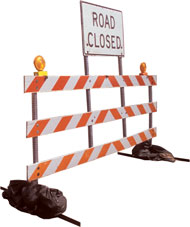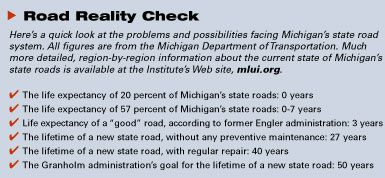Thriving Communities / News & Views / Articles from 1995 to 2012 / State Road Repair Program Deeply Flawed
State Road Repair Program Deeply Flawed
Institute study confirms “fix it first” is now crucial
March 24, 2003 | By Kelly Thayer
Great Lakes Bulletin News Service
 | |
| MLUI/Pat Owen |
Despite the billions of dollars that the Michigan Department of Transportation has spent to repair its ragged road system, the state’s highways have scarcely improved since the current rebuilding program began in 1997, according to an exclusive analysis of state records by the Michigan Land Use Institute. As a result, Michigan’s road conditions continue to rank among the worst in the nation.
The Institute’s study, based on MDOT’s internal road repair data, found that the state allowed some roads to decay prematurely while it poured money into patching old ones that instead needed complete reconstruction. The investigation also found that this maintenance approach actually drove up costs and that the transportation department spent a much smaller percentage of its budget on repairs than it claimed.
The Institute concluded that by continuing to spend money expanding its road system even while existing roads crumbled and repair costs soared, the department only made matters worse. As a result, the state is trapped on an expensive treadmill and what was once a vexing pothole problem is now a full-blown repair crisis.
 |
| MLUI/Pat Owen |
“The taxpayers and the economy can’t absorb the costs of building new roads when we have so many roads, bridges, schools, and entire communities that have fallen into a blighted state of disrepair,” said Tom Barwin, city manager of Ferndale, a Detroit suburb, and a founding member of the Michigan Suburbs Alliance.
Asked to comment on the Institute’s findings, Governor Jennifer Granholm, a Democrat, indicated that her administration had come to a similar conclusion and was taking a new approach.
“Michigan families deserve better roads right now,” the governor said in a written statement. “We must focus on fixing the roads we have today before we look to expanding tomorrow. I am directing that our transportation spending . . . focus on preservation first.”
Crisis Offers Opportunity
The statement, which was released to both the Institute and the general public on January 31, accompanied an executive action by the governor that partially fulfilled her campaign pledge to “fix it first.” The move diverted $150 million from building roads to repairing them instead. This undid a portion of Build Michigan III, a $900 million road-building program launched by former Governor John Engler during his final term.
The Institute’s findings come as Michigan faces a $1.8 billion budget deficit in the fiscal year starting Oct. 1, 2003. State and national Smart Growth experts believe the Institute’s analysis and the flagging economy could boost Gov. Granholm’s chances of making her money-saving “fix it first” philosophy stick.

The state Legislature is also weighing its option to more carefully examine the state’s transportation spending. “The transportation department usually has the ability to set the priorities,” said state Representative Scott Shackleton, a Republican from Sault Ste. Marie and chair of the House Appropriations Transportation Subcommittee, which oversees MDOT’s budget. “But if we look closer and decide, ‘Hey, you’re on the wrong track,’ then we can change the direction. But it would be micromanagement for the Legislature to go too far.”
Adding It Up
The Institute’s analysis found that in 2000, after three years and $2.5 billion in repairs, the percentage of state roads with seven or fewer years of useful life remaining shrank by just one-tenth of a percentage point, from 57.5 percent to 57.4 percent of all state-maintained roads.
The Institute also found fault with how the state began characterizing the quality of its roads during the Engler administration. According to the transportation department, all roads with at least three years of life left in them are defined as “good.” In reality, roads this near the end of their useful life are often so bumpy that that they damage shocks, tires, mufflers, and other vehicle parts. So, while the state declares that it’s nearing its 2007 repair goal of having 90 percent “good” roads, the American Society of Civil Engineers this year said the cost of damage from Michigan’s highways still averages $260 per motorist, or $1.8 billion, annually.
The Institute’s analysis also refuted the transportation department’s written claim, made during the Engler administration, that it devoted nearly all of its road dollars to repair. MDOT asserts in budget reports that 94 percent of its spending goes to road repair and just 6 percent for new road construction. In fact, the Institute found that the agency has spent 69 percent of its budget for repairs and 31 percent on brand new pavement from late 1997 to 2003.
During that period, MDOT spent $350-$500 million annually on new road construction, which more than consumed revenues from a 1997 boost in the state gasoline tax and other fees that the agency pledged would go strictly for road repairs.
What’s worse, the longer Michigan’s road repair mess continues, the more difficult and expensive it is to catch up. MDOT itself acknowledges that it costs five times less to keep a road in continuously good shape than it does to let it decay significantly before fixing it. That is because timely maintenance avoids severe repair problems and significantly extends the lifetime of a road.
Citizens Point Way to Genuine Progress
As the governor continues to grapple with wretched roads, she will be backed by a large, organized, vocal constituency for “fix it first,” much of it inspired by the Michigan Transportation & Land Use Coalition — a shared project of the Institute and the Michigan Environmental Council. In recent years, these groups have stopped new roads in nearly every region of the Lower Peninsula, prompted Lansing to increase public transit funding, and helped expose the scale of the road repair backlog.
Many of those who helped crack Michigan’s road-building monolith say they will continue to watch Lansing closely. One of them is Vicky Kovari, lead transportation organizer for the faith-based metropolitan Detroit coalition, MOSES, which drew 5,000 citizens and politicians to a “fix it first” rally in Lansing last September.
“It will take both courage and tenacity to hold officials accountable to their commitments over the next few months and years,” she noted.
Kelly Thayer, a journalist and transportation project manager at the Institute, has worked to reshape Michigan’s transportation policies since 1998. Reach him at 231-882-4723, ext. 13 or kelly@mlui.org. More information on Michigan’s roads, including the analysis informing this article, is at www. mlui.org.
CONTACTS:
Governor Jennifer Granholm
Phone: 517-335-7858
Email: Go to www.michigan.gov/gov
Michigan Department of Transportation
Phone: 517-373-2160
Email: mdotdirector@michigan.gov
State Representative Scott Shackleton
Phone: 517-373-2629
Email: sshackleton@house.state.mi.us
Vicky Kovari
MOSES
Phone: 313-962-5290
Email: vkovari@aol.com





